|
Andy Whall on Live
Art, Art Surgery and ALIAS
Andy Whall is an artist and
independent curator who has lived in Cornwall since the mid 90s
Interview by Rupert White
Andy, what are your abiding memories
of your time at art school? What were your influences then, and what
kind of work were you making?
I went to Cardiff Art College in the mid and late 80’s. My Foundation
course had been excellent, I did this in Leamington Spa and was taught
by fairly recent graduates from Coventry Polytechnic and members of Art
& Language. This context and the fact that my father was a senior
lecturer and a conceptual/installation artist himself meant that I
started my BA course in Cardiff with high expectations.

Degree Show, Cardiff
Consequently
I was a bit disillusioned by the quality of teaching at Cardiff. Not all
of it of course, but I think that the course was undergoing change and
in the mixed media department we seemed to have a very high turnover of
staff. High-points of teaching were provided with fellowships that
included Helen Sear, Rose English, Mona Hatoum and lecturers that
included Kevin Atherton.
Bearing in mind this was the mid 80's. Thatcher provided us with some
fun. She dealt huge cuts within education which the then fairly
political student body protested against. Fine art mounted an occupation
that lasted several weeks. We banned staff from seminars and tutorials,
which worked well. We started a student paper, which didn’t work so
well.
This segued pretty neatly into more political action during the miners
strike. It's hard to believe now but as students we were supporting a
pit and mining community in the Valleys. We actually went up there with
a bucket of money and a delegation of miners came down to the college.
Not much time for art then.
I remember working with another student John Murphy also from the
foundation at Leamington Spa. We were doing ‘dialogues’ working together
on performative stuff. We did something for the national Review of Live
Art and in the write up it was called one of the worst things the
reviewer had ever seen. We were quite pleased. We were also quite
pleased when at the beginning of the third year we were told we would
fail our degrees if we carried on working in this way, assessors needed
to know who had done what.
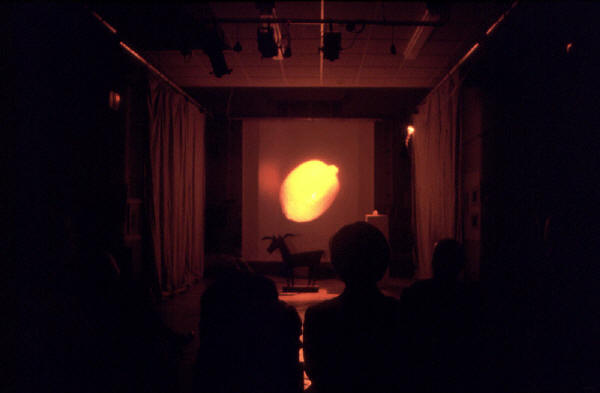
SLAP, St Ives Island Centre
Considering
that I had been a bit of a difficult student (or a pain in the arse), it
was quite surprising when a year after graduating I returned to the
college to do a two-year MA. Teaching highlights included seminars and
tutorials from Terry Atkinson and John Roberts (writer)
I had studied in Cardiff and had just finished the MA. I’d shown work at
Chapter Arts Centre, I’d received a Welsh Arts Council travel grant and
had jointly run a small 3/4 artist run space on the edge of the docks.
The regeneration of this area meant we were served notice and rather
naively we moved out.
In 80's there were still quite a few performance events running; I did a
few of these including in 1983 Coventry Media Show and the Sheffield
Events Week and a few years later in 1987 I did the national Review of
Live Art at The Arnolfini and a Live Art Platform at University
Brighton. Somewhere between these dates was the NRLA event at Chapter.
Apart from these events there didn't seem to be much of an
infrastructure for performance and installation art outside of London.
There certainly wasn't in Cardiff.
Surfing and climbing was taking up quite a lot of my time. And over the
next few years 1989 to 1994 I began a series of quite long trips
starting in Europe, USA and culminating in a series of three month stays
in Morocco.
Then you came to St Ives… what brought you down to Cornwall and
what were your impressions of the place?
Coming
back from one of these trips with no where to live, I went down to see
Andy Hughes in St Ives. I was living there shortly after in 1996.
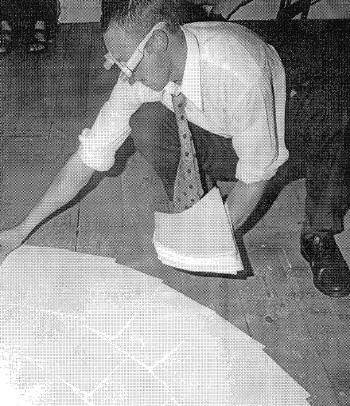
Questioning Office of Art launch, New Millenium Gallery, 1999
My first impressions were brilliant; I lived near the beach, and surfed
as much as I wanted. I was writing up a novel I’d written. And I made a
lot of friends pretty quickly. The Sloop was a decent pub back then and
you could get free food there on at least two evenings a week. There
were lots of artists which made for a fun environment. I remember going
to a ‘forum’ and the first person I heard talking was Ken Turner talking
about Merleau-Ponty. Without reflecting too much at the time, it did
seem a fantastic place to have moved to. It’s worth saying that I
wasn’t even that familiar with its art historical tradition; I knew more
about the surfing and climbing in the area than the art.
How did you start to make and show
your own work in this context? Who were your peers? What were the issues
at stake and what role did Tate and Newlyn have then?
I think that there were a number of contexts. The St Ives September
Festival in 1996 was the first opportunity to do something. Other
artists were opening up their studios, there was a handful of artists
that worked in other ways and we decided to do an event for the
festival. It was called SLAP and included myself, Ken Turner, Andy
Hughes and Alaric Sumner. It was an evening at the Island Centre (picture
above), we then also did it at Newlyn Gallery, without too much
fuss. I realized at this point that there was a good audience for this
kind of thing and as far as we knew there hadn’t been much of this sort
happening in the area.
Following that myself, Ken Turner and Andy Hughes opted for a more
ambitious project called the Questioning Office of Art, which we
launched with a performance at The New Millennium Gallery (picture
above). This was part of the grandly named Peninsula Project
and offshoot of the ‘Quality of Light’ programme run by the Tate. During
this period Mike Tooby (then Tate curator) was very supportive of what we were doing, as was
the St Ives Times and Echo.
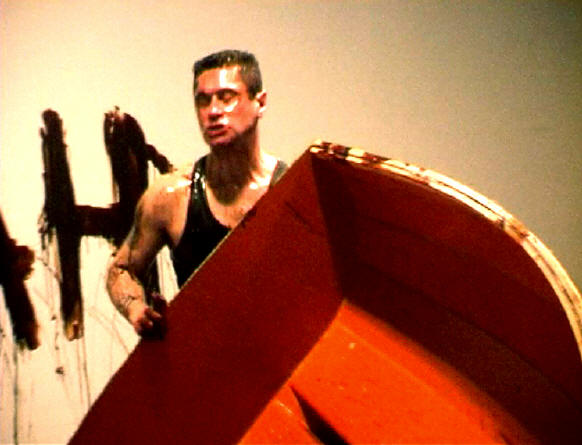
Real Art (and a sense of place), Newlyn Art Gallery, 1999. Performance
Andre Stitt
In
many ways it was a prototype DIY project. We had £500 funding. Andy and
I used all our contacts and friends to get a program together which
included artists Adam Dant, Helen Sear, Bruce Gilchrist, Phil Collins
and 20 others. It was site specific: we used beach huts, the beach, the
streets and the Tate Gallery and the Salthouse and New Millennium
Galleries.
At that time it was relatively easy to make relationships. Galleries
responded to our requests and proposals, audiences were happy and
artists were happy enough to come and work for us as long as we put them
up. The visiting artists had a good time and also integrated with the
local artists and community.
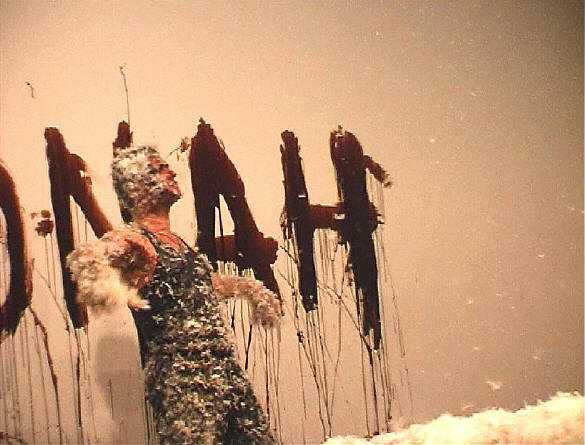
Real Art (and a sense of place), Newlyn Art Gallery, 1999. Performance
Andre Stitt
It’s worth saying that at the time St Ives had a good party vibe and a
very crossover feel: artists mixed with surfers, there were not many
generation barriers and there were three clubs open in the town. I
suppose there was also an optimism that because there was a body of new
artists working in the town it was expected that their presence would
supersede the historical generation. Of course that didn’t happen. It
became easier to endlessly repackage the old rather than embrace a
difficult new that was in many ways unproved.
How was Art Surgery formed and what kind of events did it gone on
to organise?
Art Surgery was a kind of follow on from the Questioning Office of Art.
I’d been approached by the Arts Council with an offer of support if I
put together another live art project.
A couple of new collaborations had occurred in the meantime. ‘START’ an
art fanzine had a stuttering run as a kind of art mag. It focused a few
minds though, and there were some memorable pieces of writing.
One
of the editors on this was Pat Finn. Finn had settled in St Ives
recently but tragically died shortly after. In the short time I knew her
though I was impressed by her vision and dedication to making St Ives a
place where live art/installation artists could work and live.
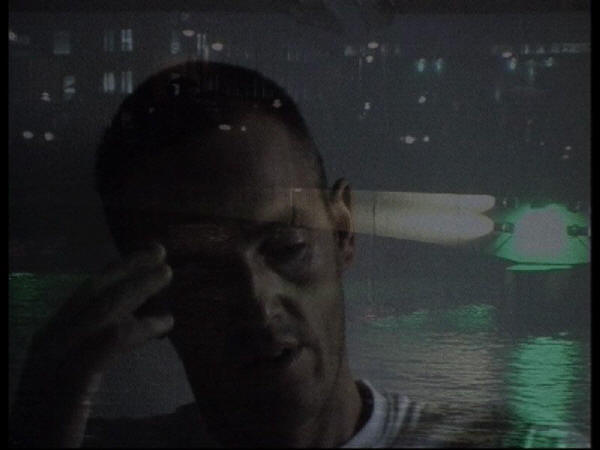
Temple
Bar Gallery and studios international exchange programme 2002.
Her experience and contact fed directly into our collaboration based in
the old surgery where she now lived, so the surgery became Art Surgery.
Although she became too ill to work on the project, she introduced me to
Paul O' Neill. Paul gave me a number of contacts to pursue and over a
period of funded research the project Real Art (and sense of place) 1997
came about. Again, like the QOOA, we looked for a number of sites and
venues.
Newlyn Art Gallery and The New Millennium both hosted parts of the
project although they had no curatorial input. The project was quite
ambitious with artists including Andre Stitt (pictures above X2) and Bobby Baker. Emily Ash the director of Newlyn at the time
estimated that the crowd for Bobby Baker was probably the most people in
the gallery at any one time.
Real Art (and a sense of place) was in many ways a watershed for Art
Surgery. As a sad postscript Pat Finn had become very ill and died in
December 1999. At her request I put together an artists’ exchange
between Temple Bar Gallery and Studios in Dublin, and St Ives. During
November 2000 I spent a month in residence in Dublin and in 0ctober 2001
(picture above), Katie Holten spent 7 weeks in St Ives
staying and sharing her work from Pat Finn’s house. The resulting
drawing and installation work by Katie Holten and I traversed different
media and different representational forms, producing challenging work,
and was shown at The New Millennium Gallery (picture below).
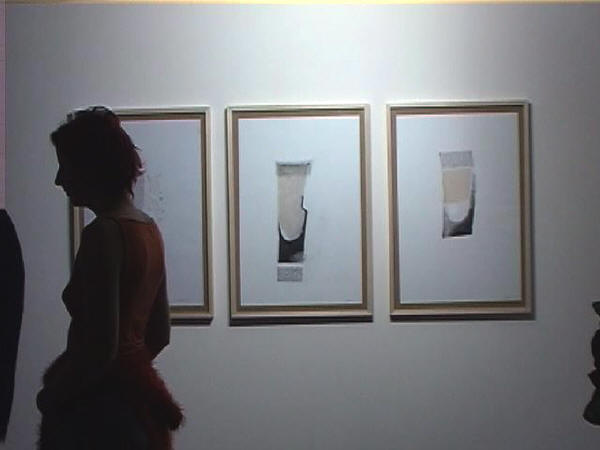
Temple Bar
Gallery and studios international exchange programme 2002.
Dealing
with notions of poetry and theory in video art, Videoteque 2002 at Ten
Gallery, St Ives was an international showcase co-curated with Delpha
Hudson (picture below). Ten, an independent gallery space was positioned in the centre
of St Ives with window frontage onto a busy street, enabling projections
inside and onto the window of the gallery to be seen on a 12 hour cycle.
The projected video images challenged the object-bound nature of most
art from St Ives, conceptually encouraging a more transient and
ultimately poetic encounter with moving images. Artists shown included
Marcus Coates, Tony Hill, Werther Germonderi, Miranda Whall and twenty
three others. An edited and extended version of this project was shown
later in 2002 as Videoteque 2 at Newlyn Art Gallery.
In collaboration with Newlyn Art Gallery, Live Platform 2003 was set up
to provide a context for artists based in the South West, to present
their own work, to see work, and discuss performance and live art in the
context of the SW region. Unlike many other artforms performance has not
often been systematically documented and represented, nevertheless
histories do exist. Roland Miller, who has worked in performance since
the 70s, returned to Penwith to perform The Paper (picture below), and Julie Bacon, an
important contemporary performance practitioner also returned to the SW
to perform Act-Archiving Works.
What was the concept behind Art Surgery? Is it possible to say?
It's
difficult to pin down a single concept that Art Surgery stands for. I
suspect like many organisations the initial motivation was a political
one within an art context. A pragmatism sets in as subsequent funding
bids necessitate packaging the projects within what can at times seem
like a funding-led context. I also found that the earlier projects that
were ambitious in terms of curatorial concept and context always left me
a little disappointed when artists didn’t always embrace the discursive
context that Art Surgery emphasised as curators.
The shift to a more diverse and pragmatic approach manifested itself in
Tract in 2006. Again we worked with a lot of artists of varying degrees
of experience. From a few recent graduates to hugely influential artists
such as Alastair Maclennan. Tract occupied
a three month slot In Newlyn's programme for that year. There was a lot
of work and certainly gave many people a chance to see quality live
work, I suspect it also reached new levels for Art Surgery in terms of
new audiences. Its fair to also say that Kira O Reilly's work attracted
a massive amount of publicity. In a two hour period the website had over
8,000 hits and the story was international news with articles in all the
major international papers. Interestingly though none of this made the
slightest bit of difference in terms of audience numbers for the
performance on the night.
The working team for Tract was myself, Blair Todd and Delpha Hudson.
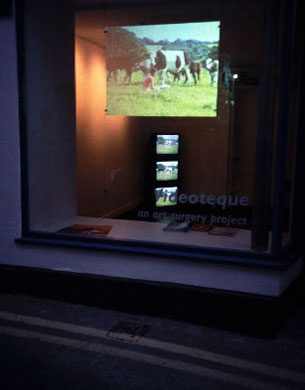
Videoteque, Ten Gallery, St Ives 2002
What do you see as the particular strengths of Live Art?
That's a strange question, you mean the
strengths in comparison to other art forms?
Yes.
From a curatorial point of view for a
fairly limited budget you can put on a project or event with a large
number of artists at diverse and multiple venues. The range of artists
can be broad and it will inevitably sustain a challenge at some point
and level to the dominant or mainstream.
I simply can’t see this happening within other contexts traditions say
painting for example.
You're also involved with ALIAS. Can you explain to readers what
ALIAS is, how it came about and what your role is within it?
'Alias' started in 1999 as a pilot scheme initiated by the Arts Council
South West, to support the professional development of visual artists.
The initial research resulted in an advisory service for artist led
groups, steered for eight years by a diverse group of artists
representative of different geographical areas of the region.
In 2007, that initial scheme has grown into
an independent CIC (Community Interest Company) refreshing the original
aims and adopting a new organisational structure. Alias’ main aim is to
support artist led culture across South West England, by providing an
advisory service for artist led groups, distributing information about
professional opportunities and by estimating a critical context around
artist led activity.
Artists Paul Harper, Neil Walker, Julie
Penfold, Hal Camplin and Andy Whall form the board of directors. Paul is
the Company Secretary and Julie is the Chair.
At the current stage of development, alias’
main concern is to engage the community of artist led initiatives we
have been working with on a horizontal basis. Our goal is to create an
empowering platform for the development of artist led activity in the
region, where artist led groups can gain visibility, knowledge and
strength by sharing and confronting their experiences.
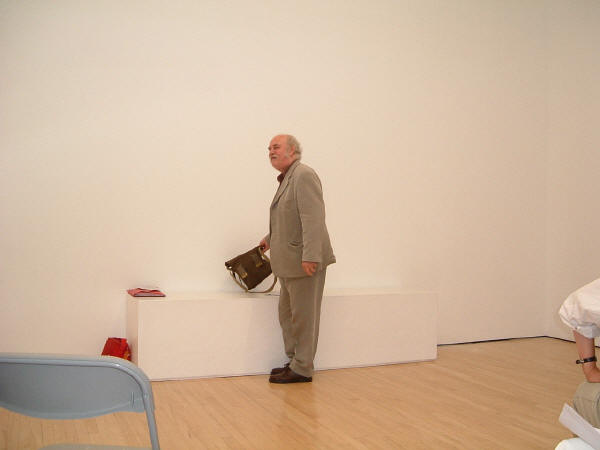
Live Platform, Newlyn Art Gallery 2003. Roland Miller performance
talk.
What is the significance of artist led activity in a place like
Cornwall?
In
reality the term 'artist led' is not a particularly helpful term. I
suspect its meaning has changed over the last ten years or so. It's
probably fair to say that 'artist led' projects such as QOOA, PALP and
Art Surgery led a phase of development that has been recognised and in
some ways absorbed by (for the sake of a better word) the mainstream.
So now In Cornwall we have 'artist led' and 'site specific'. Which if we
think about it are concepts that have been around in a fairly cohesive
and theorised version since the 60’s.
I think with a few of Art Surgery’s early
projects and the QOOA we were not only putting on 'site specific' and
'artist led' but we were asking questions some of which were about art.
The 'site specific' and 'artist led' projects we are now getting are
generally funding led, and to a degree they are co opted by an arts
administrative led culture and ask very few questions. It's not too hard
to see how this has happened. Initially post 60’s up until the early
years of the Tate St Ives anything that wasn’t a painting, print,
drawing or sculpture was a rarity. The contextual space opened up a bit
and QOOA and Art Surgery began filling it, as did PALP. A decade or so
later it wasn’t unusual anymore to see some performance, say, or an
installation.
Of course historically it has always been the case that artists have
occupied spaces and buildings until institutions appropriate those
spaces...and to a degree this institutionalises artists.
The problem we now have in Cornwall, is that the initial exciting phase
is over. 'Artist led' and 'site specific' are not new anymore, nor is
performance and installation. Artists still need to ask questions of the
contexts they find themselves in.
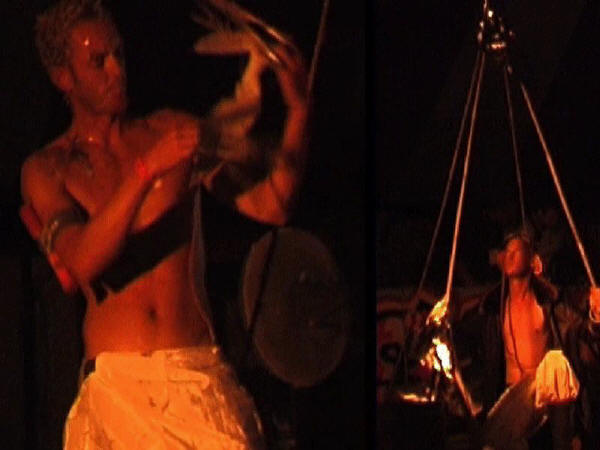
Lizard Festival, 2000
'Artist
led' activity keeps alive the idea that there is a scene, without the
'artist led' stuff, there would not be much at all: a handful of
galleries showing 'serious' work and the big three of four institutions
doing their best. However the scene is very lazy and there is little
that I can see that is 'artist led' or otherwise asking questions of, or
challenging, the 'scene'.
What passes for discourse down here is paltry and reactionary led by
grim critics of the Peter Davies variety. Which unfortunately gets taken
seriously. Obviously I am fixed ideologically in a given time and place,
but I suspect the problem may lie in the Art Colleges.
From what I can see all the wrong things happen in them for all of the
wrong reasons. Which of course was different in my day, because during
that period in the mid 80's it was impossible to escape politics and it
became clear to even the dimmest student that politics framed the art.
It was even perceived that art actually might have a role in political
change. I suspect that after several decades it's now pretty difficult
and unpopular to occupy such ideologically black and white territory.
But a preoccupation with surface, intertextuality, pastiche and irony
has rendered reduced? most practitioners to a kind of myopic fiddling.
Who knows? If the global capitalist economy fails completely, there
won't be much use for commercial galleries and the Tate Gallery St Ives
will be filled with refugees. We might find that art takes its place in
an ideological struggle once again.
http://aliasarts.org
12/12/08
|










